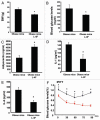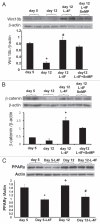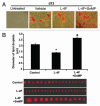ApoA1: mimetic peptide reverses adipocyte dysfunction in vivo and in vitro via an increase in heme oxygenase (HO-1) and Wnt10b
- PMID: 22306989
- PMCID: PMC3318105
- DOI: 10.4161/cc.11.4.19125
ApoA1: mimetic peptide reverses adipocyte dysfunction in vivo and in vitro via an increase in heme oxygenase (HO-1) and Wnt10b
Abstract
Insulin resistance is a risk factor in the development of type 2 diabetes and is a major cause of atherosclerosis. Reduction in heme oxygenase (HO-1) has been shown to exacerbate vascular dysfunction and insulin resistance in obese mice and involves a decrease in adiponectin levels. Adiponectin is released from mesenchymal stem cell (MSC)-derived adipocytes, its levels are decreased in type 2 diabetes. We hypothesized that the apoA1 mimetic peptide, L-4F, will target the expression of the HO-1-adiponectin axis and reverse adipocyte dysfunction both in vivo and in vitro. The administration of L-4F [2 mg/Kg/daily (i.p.) for 4-week to 8-week-old obese (ob) mice restored adipocyte function, increased adiponectin release (p < 0.05) and decreased the levels of IL-1 and IL-6 (p < 0.05)]. These perturbations were associated with an increase in insulin sensitivity (p < 0.01 vs. untreated ob mice) and decreased glucose levels (309 + 42 vs. 201 + 8 mg/d after L-4F treatment). Treatment of both mesenchymal stem cell (MSC)-derived adipocytes with L-4F (50 μg/ml) increased adiponectin (p < 0.05), decreased IL-1 and IL-6 (p < 0.05) levels and increased MSC-derived adipocyte cell numbers by 50% in S phase (p < 0.05). MSC-derived adipocytes treated with L-4F increased WNT10b and decreased Peg 1/Mest. Inhibition of HO activity reversed the decrease in the adipogenic response gene, Peg 1/Mest. An increase of HO-1 expression by L-4F increased insulin-receptor phosphorylation. These findings support the hypothesis that L-4F increases early adipocyte markers, HO-1-adiponectin, WNT10b and decreases Peg1/Mest, negative regulators of adipocyte differentiation.
Figures







Similar articles
-
Increased heme-oxygenase 1 expression in mesenchymal stem cell-derived adipocytes decreases differentiation and lipid accumulation via upregulation of the canonical Wnt signaling cascade.Stem Cell Res Ther. 2013 Mar 12;4(2):28. doi: 10.1186/scrt176. Stem Cell Res Ther. 2013. PMID: 23497794 Free PMC article.
-
L-4F treatment reduces adiposity, increases adiponectin levels, and improves insulin sensitivity in obese mice.J Lipid Res. 2008 Aug;49(8):1658-69. doi: 10.1194/jlr.M800046-JLR200. Epub 2008 Apr 19. J Lipid Res. 2008. PMID: 18426778 Free PMC article.
-
Heme oxygenase (HO-1) rescue of adipocyte dysfunction in HO-2 deficient mice via recruitment of epoxyeicosatrienoic acids (EETs) and adiponectin.Cell Physiol Biochem. 2012;29(1-2):99-110. doi: 10.1159/000337591. Epub 2012 Mar 1. Cell Physiol Biochem. 2012. PMID: 22415079 Free PMC article.
-
Epoxyeicosatrienoic acids and heme oxygenase-1 interaction attenuates diabetes and metabolic syndrome complications.Prostaglandins Other Lipid Mediat. 2012 Jan;97(1-2):1-16. doi: 10.1016/j.prostaglandins.2011.10.002. Epub 2011 Nov 15. Prostaglandins Other Lipid Mediat. 2012. PMID: 22100745 Free PMC article. Review.
-
Oxidized HDL is a potent inducer of adipogenesis and causes activation of the Ang-II and 20-HETE systems in human obese females.Prostaglandins Other Lipid Mediat. 2016 Mar;123:68-77. doi: 10.1016/j.prostaglandins.2016.04.004. Epub 2016 May 11. Prostaglandins Other Lipid Mediat. 2016. PMID: 27179555 Review.
Cited by
-
Combination of 5-aminolevulinic acid and ferrous ion reduces plasma glucose and hemoglobin A1c levels in Zucker diabetic fatty rats.FEBS Open Bio. 2016 Apr 29;6(6):515-28. doi: 10.1002/2211-5463.12048. eCollection 2016 Jun. FEBS Open Bio. 2016. PMID: 27239432 Free PMC article.
-
ABCA1 agonist peptides for the treatment of disease.Curr Opin Lipidol. 2016 Feb;27(1):40-6. doi: 10.1097/MOL.0000000000000258. Curr Opin Lipidol. 2016. PMID: 26655293 Free PMC article. Review.
-
The apolipoprotein A-I mimetic peptide, D-4F, restrains neointimal formation through heme oxygenase-1 up-regulation.J Cell Mol Med. 2017 Dec;21(12):3810-3820. doi: 10.1111/jcmm.13290. Epub 2017 Aug 2. J Cell Mol Med. 2017. PMID: 28767201 Free PMC article.
-
The unsolved mystery of apoA-I recycling in adipocyte.Lipids Health Dis. 2016 Feb 24;15:35. doi: 10.1186/s12944-016-0203-x. Lipids Health Dis. 2016. PMID: 26911989 Free PMC article. Review.
-
PPARδ binding to heme oxygenase 1 promoter prevents angiotensin II-induced adipocyte dysfunction in Goldblatt hypertensive rats.Int J Obes (Lond). 2014 Mar;38(3):456-65. doi: 10.1038/ijo.2013.116. Epub 2013 Jun 19. Int J Obes (Lond). 2014. Retraction in: Int J Obes (Lond). 2024 Oct;48(10):1515. doi: 10.1038/s41366-024-01588-2. PMID: 23779049 Free PMC article. Retracted.
References
-
- Sivitz WI, Wayson SM, Bayless ML, Sinkey CA, Haynes WG. Obesity impairs vascular relaxation in human subjects: hyperglycemia exaggerates adrenergic vasoconstriction arterial dysfunction in obesity and diabetes. J Diabetes Complications. 2007;21:149–157. doi: 10.1016/j.jdiacomp.2005.12.003. - DOI - PubMed
Publication types
MeSH terms
Substances
Grants and funding
LinkOut - more resources
Full Text Sources
Miscellaneous
